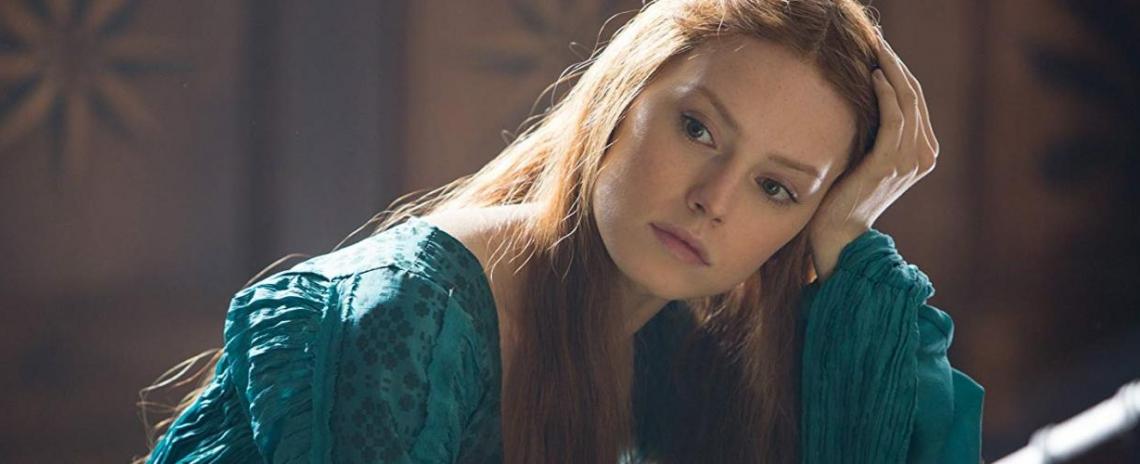Claire McCarthy’s Ophelia is the latest in a long line of cinematic Shakespeare adaptations that take the Bard’s words and add a supposedly creative twist. What sets the director’s revisionist take on Hamlet apart from all the others is its hectoring insistence on being different. The film’s opening image finds Daisy Ridley submerged in water, clutching a bouquet of flowers. Her Ophelia is not like any iteration of the character seen before (unless, of course, the viewer has read the 2008 novel by Lisa Klein on which the film is based). She addresses the viewer directly in voice-over: “You may think you know my story. Many have told it. It has long passed into history ... into myth.” Ridley then submerges as the film’s title appear. This fourth-wall-breaking narration device is discarded after a minute or two, but its purpose is clear: to emphasize that now is the time for Ophelia to tell her side of the story. Yet, by doing this, the film labels itself subversive in a way that is never fully realized.
The “same story, different perspective” gimmick is nothing new. It’s even been done for Hamlet before, most famously in Tom Stoppard’s 1966 play and its 1990 film adaptation, Rosencrantz & Guildenstern Are Dead, which manages to add a metafictional twist along the way without ever removing the story from its Shakespearean setting. Ophelia’s opening monologue insinuates that its relationship to the story of Hamlet is similar, if more period-drama traditional — the framework of the narrative remains the same, but the way each character experiences that narrative differs.
For much of the first half, McCarthy’s female-centric take on Hamlet establishes the story that viewers presumably already know: Ophelia captures the attention of Hamlet (George MacKay), the son of Queen Gertrude (Naomi Watts) and an unnamed king, at a pivotal moment for the kingdom. While the adults deal with the tension that comes with being on the brink of war in the wake of the king’s death, Ophelia and Hamlet’s relationship only grows stronger as their sanity wears thinner. Because Ophelia isn’t royalty — Gertrude took her in at a young age to help bring her up in ways her father, Polonius (Dominic Mafham), and brother, Laertes (Tom Felton), couldn’t — any potential union with Hamlet is essentially forbidden, something that Hamlet’s uncle-turned-king, Claudius (Clive Owen), is more than willing to point out.
It isn’t until the second half that Ophelia begins to diverge from Shakespeare’s story. From the introduction of Mechtild (also Watts), the long-lost sister of Gertrude who is well-versed in witchcraft, to the complete overhaul of Ophelia’s arc, McCarthy’s adaptation seemingly contradicts the intent conveyed in its opening monologue. To be clear, there is no inherent folly in reworking one of Shakespeare’s plays into a (mostly) original vision. That’s why movies like West Side Story (1961) and 10 Things I Hate About You (1999) work — the instructive difference being that they never allude to their repurposing of the Bard’s stories. Given that Ophelia opens with a speech that recalls the events of Hamlet and states that the story that audiences are about to hear will provide the other side of that well-known tragedy, the film owes it to the filmgoer to adhere to Shakespeare’s account, at least in terms of plot. Instead, Ophelia violates its own rules and strays from the beaten path to tell an entirely reimagined version of Hamlet. This feels like a Brutus-level betrayal of the expectations that McCarthy herself establishes.
While the story is derailing, it’s at least enjoyable to focus on the film’s immersive aesthetics. The dresses of Daisy Ridley and Naomi Watts are intricately crafted, flowing and breathing as if they were alive themselves. The royal garments that adorn the men earn similar praise — costume designer Massimo Cantini Parrini achieves an elegance that elevates the film. Production designer David Warren and set decorator Ute Bergk also deserve recognition for the sheer amount of detail crammed into every shot. When one thinks of Hamlet, visions of men in drab garb holding skulls come to mind. The look of Ophelia effectively erases these gray perceptions by filling the background with evocative colors, dreamlike sets, and floral patterns.
Visually, Ophelia is enchantingly wispy. Structurally, it’s cleverly assembled. Nonetheless, Ophelia’s opening statement proves to be its downfall. If not for the setup, which frames the film as the B-side to Hamlet, the film would be notable for adding some much-needed flair to a character with untapped potential. Yet, because it positions itself the way it does, Ophelia comes across as a film that gives up halfway, erasing key plot points and adding in frivolous ones while still trying to maintain the illusion that Ophelia and Hamlet present different perspectives on the same events. The changes made are so drastically divergent, there’s simply no way that this could be true — it’d be understandable if Ophelia felt one way about a situation and Hamlet felt another, but it’s ludicrous to assume that the action-packed events of Ophelia’s latter third could somehow be reconciled with Hamlet’s fifth act. Ophelia would be have more memorable if it had avoided making promises it couldn’t keep. Or, better yet, if it had heeded Shakespeare’s admonition: “Above all else: to thine own self be true.”
Rating: C


